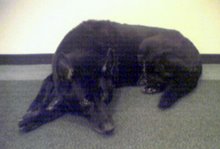Today, Ivor is a Tamaraw. he is a small wild buffalo weighing about 300 kg (660 lb). He lives in dense forest with open glades for grazing, such as are created by fires
or landslides. He also prefers to be close to water for wallowing. He feeds on grasses, bamboo shoots and aquatic vegetation. His small size and great strength enables him to push through dense jungle and climb steep mountains. Tamaraw associate in pairs, rather than herds, except when the cows are about to give birth.
The tamaraw was first documented by Western science in 1888. It has never been recorded from any area other than the island of Mindoro (Philippines). I guess these scientests have never heard of Ivor the Tamaraw who resides in Washington, DC. Prior to about 1900, most people had avoided settling on Mindoro, since it harbored a particularly virulent strain of malaria. Thus human impact on the
tamaraw had been slight. At one time the tamaraw lived throughout most of the island. With the advent of anti-malarial medicines near the turn of the century,
Mindoro became more accessible to human settlement. Since that time, the tamaraw's population has been reduced from abundance to a critically low level.
By 1966 its range had been reduced almost entirely to 3 principal areas: Mt. Iglit, Mt. Calavite, and the vicinity of the Sablayon Penal Settlement. By
2000, reports suggested that tamaraw were restricted to just 2 areas: the Iglit Ranges, in Mounts Iglit-Baco National Park, and Aruyan, with very few data
about numbers in either site.
The tamaraw has declined mainly because of hunting, especially after the introduction of modern firearms after WWII and the Vietnam war; and habitat loss,
due to settlement, logging and ranching, after malaria was brought under control around 1900. Disease (rinderpest) caught from domestic cattle introduced
to the island in the 1930's has also had a serious impact.
Thursday, June 21, 2007
Subscribe to:
Post Comments (Atom)

1 comment:
Why would anyone hunt an animal as adorable as Ivor?
Post a Comment